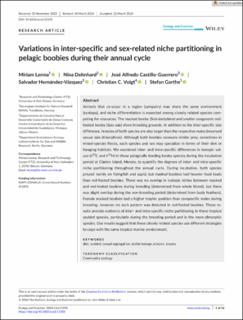| dc.contributor.author | Lerma, Miriam | |
| dc.contributor.author | Dehnhard, Nina | |
| dc.contributor.author | Castillo-Guerrero, José Alfredo | |
| dc.contributor.author | Hernández-Vázquez, Salvador | |
| dc.contributor.author | Voigt, Christian C. | |
| dc.contributor.author | Garthe, Stefan | |
| dc.coverage.spatial | Clarion Island, Mexico | en_US |
| dc.date.accessioned | 2024-04-24T12:43:32Z | |
| dc.date.available | 2024-04-24T12:43:32Z | |
| dc.date.created | 2024-04-17T08:39:46Z | |
| dc.date.issued | 2024 | |
| dc.identifier.issn | 2045-7758 | |
| dc.identifier.uri | https://hdl.handle.net/11250/3127955 | |
| dc.description.abstract | Animals that co-occur in a region (sympatry) may share the same environment (syntopy), and niche differentiation is expected among closely related species competing for resources. The masked booby (Sula dactylatra) and smaller congeneric redfooted booby (Sula sula) share breeding grounds. In addition to the inter-specific size difference, females of both species are also larger than the respective males (reversed sexual size dimorphism). Although both boobies consume similar prey, sometimes in mixed-species flocks, each species and sex may specialize in terms of their diet or foraging habitats. We examined inter- and intra-specific differences in isotopic values (δ13C and δ15N) in these pelagically feeding booby species during the incubation period at Clarion Island, Mexico, to quantify the degrees of inter- and intra-specific niche partitioning throughout the annual cycle. During incubation, both species preyed mainly on flyingfish and squid, but masked boobies had heavier food loads than red-footed boobies. There was no overlap in isotopic niches between masked and red-footed boobies during breeding (determined from whole blood), but there was slight overlap during the non-breeding period (determined from body feathers). Female masked boobies had a higher trophic position than conspecific males during breeding; however, no such pattern was detected in red-footed boobies. These results provide evidence of inter- and intra-specific niche partitioning in these tropical seabird species, particularly during the breeding period and in the more-dimorphic species. Our results suggest that these closely related species use different strategies to cope with the same tropical marine environment. diet, seabird, sexual segregation, stable isotope analysis, tropics Community ecology | en_US |
| dc.language.iso | eng | en_US |
| dc.rights | Navngivelse 4.0 Internasjonal | * |
| dc.rights.uri | http://creativecommons.org/licenses/by/4.0/deed.no | * |
| dc.title | Variations in inter-specific and sex-related niche partitioning in pelagic boobies during their annual cycle | en_US |
| dc.title.alternative | Variations in inter-specific and sex-related niche partitioning in pelagic boobies during their annual cycle | en_US |
| dc.type | Peer reviewed | en_US |
| dc.type | Journal article | en_US |
| dc.description.version | publishedVersion | en_US |
| dc.rights.holder | © 2024 The Authors | en_US |
| dc.subject.nsi | VDP::Økologi: 488 | en_US |
| dc.subject.nsi | VDP::Ecology: 488 | en_US |
| dc.source.volume | 14 | en_US |
| dc.source.journal | Ecology and Evolution | en_US |
| dc.source.issue | 4 | en_US |
| dc.identifier.doi | 10.1002/ece3.11255 | |
| dc.identifier.cristin | 2262205 | |
| dc.relation.project | Andre: INAPI-CONACyT: 411876 | en_US |
| dc.source.articlenumber | e11255 | en_US |
| cristin.ispublished | true | |
| cristin.fulltext | original | |
| cristin.qualitycode | 1 | |

